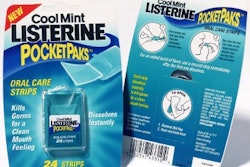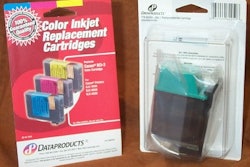Sometimes an equipment upgrade can bring unexpected benefits. That was certainly the case for American Tack & Hardware, Monsey, NY, when it purchased an up-to-date label printing station for its headquarters’ distribution center.
The station includes three Model 6406 direct thermal and thermal-transfer label printers from Avery Dennison Printer Systems (Philadelphia, PA) and upgraded software to network the printers with Amertac’s own computerized database.
The printers are used to produce three different types and sizes of labels for merchandise that is inventoried at the distribution center. Each labeler has a 6”-wide printhead that accommodates 6x4” shipping labels for case-packed products, while it also permits smaller labels to be produced in multiple rows. “For example,” says Lou Raucci, Amertac manager of packaging at Monsey, “the 1¼” labels for primary packages can be printed four-up.”
In between these two sizes, Amertac prints a 2½” label that is affixed to what the company calls a “shelf pack,” a smaller multipack of chipboard that customer distribution centers or distributors can ship to individual stores after breaking down the shipping case.
64-bit printers
The heart of the switch is essentially the capabilities of the new label printers. Powered by a 64-bit microprocessor, the Model 6406 printer offers higher-speed processing and printing for Amertac. But when asked, Amertac says speed wasn’t the primary reason for the upgrade.
Kevin Mandoske, director of manufacturing at Amertac, sees the biggest change in the quality of the labels. “With the higher print resolution of these printers, our bar codes and graphics are much cleaner and crisper than before,” he says. The new printers offer 300-dpi quality, twice the resolution of the printers they replace.
Bar codes are a big issue for Amertac, both at the distribution center and for their customers. Amertac’s distribution center, Mandoske explains, uses radio-frequency technology scanners to read the bar codes on labels so that workers pick the proper merchandise for the orders to be packaged and shipped.
And, at least one customer, a major home remodeling warehouse chain, scans the interleaved two-of-five bar code on Amertac shipping cases to update their inventory management software, rather than counting manually as other customers still do.
“Because of the improved print resolution, the bar codes are far more reliable,” Mandoske says. “Our misreads are way down from before.” Part of those problems came from ribbons curling in the older printers, which would cause a crease across the bar code. “When that happens, the code becomes unreadable, so our operators can’t scan it to pick product.”
Actual savings, too
While the print quality might have justified the upgrade alone, Amertac found that the new label printers would also generate some savings in materials and labor, too.
By eliminating the need for a full-time worker at the label printer, Amertac is enjoying an annual labor savings of at least $20ꯠ, reports Mandoske. Couple that with direct material savings of $20ꯠ, and he says the actual payback period was a little less than one year.
“In the past, we had one full-time operator to print all the labels needed by the various departments in our plant,” Mandoske explains. “With our new printers, we were able to reassign that operator. Essentially, any department worker who needs labels can key into the computer the necessary information and print the labels.”
Often, says Raucci, a department will simply call the packaging area with an order for labels. “Because all we have to do is key in the item number and the quantity of labels, we can usually have them printed by the time the person arrives from that department,” he says. “When the printing is done, all we have to do is take the label roll from the rewind unit.” Before the new label printers were installed late last year, sometimes people had to wait in line for labels. That was especially true if there were several orders for labels of the same size.
This has largely been eliminated by the 10”/sec printing speed, two-thirds faster than the 16- and 32-bit printers Amertac replaced. Add in four-up label printing on the small labels and the speed quadruples.
How the process works
Amertac’s distribution center inventories about 1꼀 different products at any time, Mandoske points out. When orders are received, Amertac’s production control department issues job tickets to the appropriate departments in the center. “With each production run, there’s a need for printed labels,” he says.
Raucci and his assistant are responsible for keeping the computerized database packed with up-to-date information on the products and label requirements. A security password is required to access the database. “We are the only two people who can create information for a new product, including the bar codes, descriptions, and so on, even illustrations.”
Once the job ticket is on the shop floor, a worker from that department will request the labels to be printed for that ticket, whether it’s the small labels for the primary package (often blister cards or skin-packed products) or for packing shelf packs, or labels for the shipping case.
Raucci says that most of the center’s production is in smaller lots where the labels are hand-applied. “Often the print runs are so small, it would take longer to change over the labeler than to do it manually,” he points out.
Other benefits, too
Typically, each of the three labelers at the print station is loaded with label stock designed for one of the packs. However, sometimes demand for one label size is high, and Amertac needs to devote two or three printers to the same size.
“There are times when we have three departments all asking for the same label size, and we can run the same labels through each printer, each doing a separate job with different graphics and bar codes,” Raucci notes. These printers take only about 90 seconds to switch from one label stock to another, much faster than the older printers.
“They took longer because of the threading procedure for the label stock. Now when you lift the door, the printhead automatically lifts off the label stock, so it’s very fast to change.”
In addition, the near-edge printhead design saves Amertac maintenance work and cost, too. “We’ve gone to high-speed ribbons now because we’re printing with just the leading edge of the printhead, instead of the whole flat head,” Raucci explains. “That really saves on the life of the printhead.” In the past, each printhead had to be replaced every two to three months. “The new ones have been operating for more than six months, and we haven’t replaced one yet,” he reports.
The move from 4”-to 6”-wide printing has really boosted output. Along with running small labels four-up, Raucci reports that he’s just converted to printing the 2½”-wide shelf-pack labels two-up, or twice as fast as before.
The 64-bit processor also permits Amertac to use more graphics than ever before without sacrificing speed. “The company uses some line drawings and some logos, along with True Type fonts that the printer considers as graphic elements,” says Mike Shabet, Avery Dennison account manager for Amertac. “These are not resident in the printer, but come in through the Windows operating system.
“This is why the 16- and 32-bit printers became inadequate. They are very slow in taking the graphics in for printing, compared to this 64-bit processor,” says Shabet.
Amertac has been using Avery Dennison software for a long time, Mandoske reports, so an upgrade wasn’t difficult to learn. The installation went well, and Raucci says the printers “are pretty maintenance-free. We just clean the printheads with a little alcohol.”
The company believes that scannable bar codes on labels will be absolutely demanded by customers in the future, as they try to save on the cost of physically verifying the contents of each box received. “It’s been headed that way for some time,” Mandoske says, “but there doesn’t seem to be ready acceptance that the vendor information about the order is 100-percent accurate.”


























